2018年11月翻译资格考试三级英语笔译实务真题及答案
- 格式:doc
- 大小:194.00 KB
- 文档页数:4
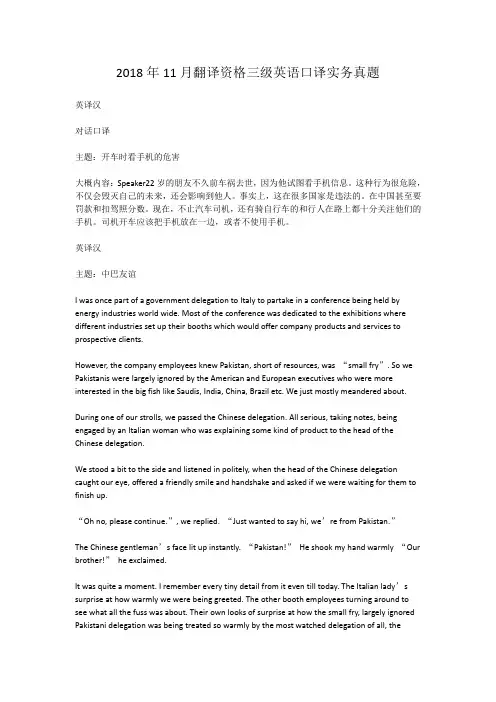
2018年11月翻译资格三级英语口译实务真题英译汉对话口译主题:开车时看手机的危害大概内容:Speaker22岁的朋友不久前车祸去世,因为他试图看手机信息。
这种行为很危险,不仅会毁灭自己的未来,还会影响到他人。
事实上,这在很多国家是违法的。
在中国甚至要罚款和扣驾照分数。
现在,不止汽车司机,还有骑自行车的和行人在路上都十分关注他们的手机。
司机开车应该把手机放在一边,或者不使用手机。
英译汉主题:中巴友谊I was once part of a government delegation to Italy to partake in a conference being held by energy industries world wide. Most of the conference was dedicated to the exhibitions where different industries set up their booths which would offer company products and services to prospective clients.However, the company employees knew Pakistan, short of resources, was “small fry”. So we Pakistanis were largely ignored by the American and European executives who were more interested in the big fish like Saudis, India, China, Brazil etc. We just mostly meandered about.During one of our strolls, we passed the Chinese delegation. All serious, taking notes, being engaged by an Italian woman who was explaining some kind of product to the head of the Chinese delegation.We stood a bit to the side and listened in politely, when the head of the Chinese delegation caught our eye, offered a friendly smile and handshake and asked if we were waiting for them to finish up.“Oh no, please continue.”, we replied. “Just wanted to say hi, we’re from Pakistan.”The Chinese gentleman’s face lit up instantly. “Pakistan!”He shook my hand warmly “Our brother!”he exclaimed.It was quite a moment. I remember every tiny detail from it even till today. The Italian lady’s surprise at how warmly we were being greeted. The other booth employees turning around to see what all the fuss was about. Their own looks of surprise at how the small fry, largely ignored Pakistani delegation was being treated so warmly by the most watched delegation of all, theChinese.It’s these small moments, these isolated incidents of human magic that people tend to miss out when they get confused over why China is so well liked by many of the developing world nations. Over the course of the conference, I interacted with other delegations from Africa, Eastern Europe, Central Asia and so on and they all had the same respect and positive impression for the Chinese delegation. Whether it was a delegate from Africa or Asia, no matter what their country’s size and importance, they were treated warmly and with mutual respect by the Chinese as if their country was the same as China in size, importance and power.From what I have experienced, Chinese partners came to our country and worked with us side by side through day and night, rain and snow. Together, we suffered the mosquito bite, lived, ate, played football and exchanged films in USB.Perhaps many people can not dawn on what I said because of their lack of personal experiences. Pakistan has always been associated with poverty, violence, terrorism and instability. But Chinese still consider themselves as one of us. Not imperial overlords or racial superiors or strict masters and so on. But comrades to the developing world, partners in our struggles and a developing country just like us who share in our troubles, concerns and visions for a mutually beneficial future.汉译英主题:中国游客出境旅游首先欢迎各国出席此次会旅游吹风会,向各国介绍中国人民出国旅游的一些情况,以便各国更加了解并采取措施来吸引更多的中国游客去贵国旅游。
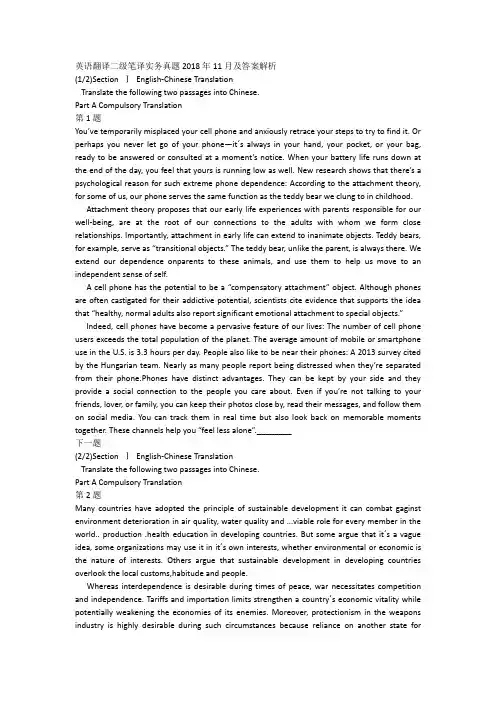
英语翻译二级笔译实务真题2018年11月及答案解析(1/2)Section ⅠEnglish-Chinese TranslationTranslate the following two passages into Chinese.Part A Compulsory Translation第1题You’ve temporarily misplaced your cell phone and anxiously retrace your steps to try to find it. Or perhaps you never let go of your phone—it´s always in your hand, your pocket, or your bag, ready to be answered or consulted at a moment’s notice. When your battery life runs down at the end of the day, you feel that yours is running low as well. New rese arch shows that there’s a psychological reason for such extreme phone dependence: According to the attachment theory, for some of us, our phone serves the same function as the teddy bear we clung to in childhood.Attachment theory proposes that our early life experiences with parents responsible for our well-being, are at the root of our connections to the adults with whom we form close relationships. Importantly, attachment in early life can extend to inanimate objects. Teddy bears, for example, serve a s “transitional objects.” The teddy bear, unlike the parent, is always there. We extend our dependence onparents to these animals, and use them to help us move to an independent sense of self.A cell phone has the potential to be a “compensatory attachment” object. Although phones are often castigated for their addictive potential, scientists cite evidence that supports the idea that “healthy, normal adults also report significant emotional attachment to special objects.”Indeed, cell phones have become a pervasive feature of our lives: The number of cell phone users exceeds the total population of the planet. The average amount of mobile or smartphone use in the U.S. is 3.3 hours per day. People also like to be near their phones: A 2013 survey cited by the Hungarian team. Nearly as many people report being distressed when they’re separated from their phone.Phones have distinct advantages. They can be kept by your side and they provide a social connection to the people you care about. Even if you’re no t talking to your friends, lover, or family, you can keep their photos close by, read their messages, and follow them on social media. You can track them in real time but also look back on memorable moments together. These channels help you “feel less alone”.________下一题(2/2)Section ⅠEnglish-Chinese TranslationTranslate the following two passages into Chinese.Part A Compulsory Translation第2题Many countries have adopted the principle of sustainable development it can combat gaginst environment deterioration in air quality, water quality and ...viable role for every member in the world.. production .health education in developing countries. But some argue that it´s a vague idea, some organizations may use it in it´s own interests, whether environmental or economic is the nature of interests. Others argue that sustainable development in developing countries overlook the local customs,habitude and people.Whereas interdependence is desirable during times of peace, war necessitates competition and independence. Tariffs and importation limits strengthen a country´s economic vitality while potentially weakening the economies of its enemies. Moreover, protectionism in the weapons industry is highly desirable during such circumstances because reliance on another state forarmaments can be fatal.For the most part, economists emphasize the negative effects of protectionism. It reduces international trade and raises prices for consumers. In addition, domestic firms that receive protection have less incentive to innovate. Although free trade puts uncompetitive firms out of business, the displaced workers and resources are ultimately allocated to other areas of the economy.Imposing quotas is a method used to protect trade, since foreign companies cannot ship more products regardless of how low they set their prices. Countries that hope to help a new industry thrive locally often impose quotas on imported goods. They believe that such restrictions allow entities in the new industry to develop their own competitive advantages and produce the products efficiently. Developing countries often use this argument to justify their restrictions on foreign goods.Protectionism’s purpose is usually to create jobs for domestic workers. Companies that operate in industries protected by quotas hire workers locally. Another disadvantage of quotas is the reduction in the quality of products in the absence of competition from foreign companies. Without competition, local firms are less likely to invest in innovation and improve their products and services. Domestic sellers don’t have an incentive to enhance efficiency and lower their prices, and under such conditions, consumers eventually pay more for products and services they could receive from foreign competitors. As local companies lose competitiveness, they become pressured to outsource jobs. In the long-run, increasing protectionism commonly leads to layoffs and economic slowdown.________上一题下一题(1/2)Section ⅡChinese-English TranslationTranslate the following two passages into English.Part A Compulsory Translation第3题人类在漫长发展进程中创造了丰富多彩的世界文明,中华文明是世界文明多样性、多元化的重要组成部分。
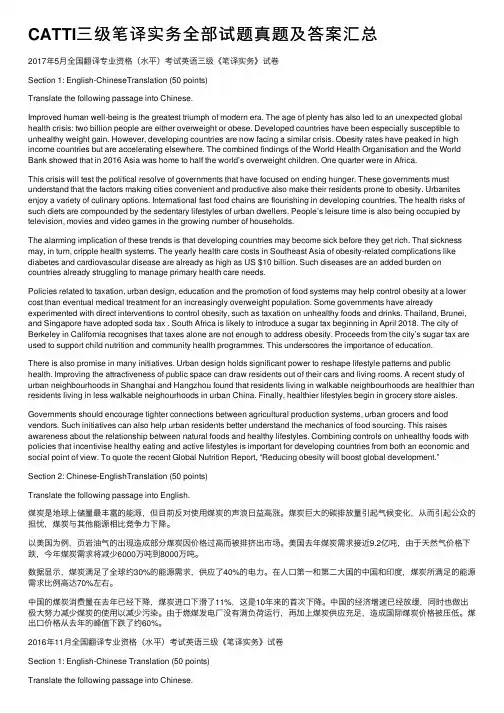
CATTI三级笔译实务全部试题真题及答案汇总2017年5⽉全国翻译专业资格(⽔平)考试英语三级《笔译实务》试卷Section 1: English-ChineseTranslation (50 points)Translate the following passage into Chinese.Improved human well-being is the greatest triumph of modern era. The age of plenty has also led to an unexpected global health crisis: two billion people are either overweight or obese. Developed countries have been especially susceptible to unhealthy weight gain. However, developing countries are now facing a similar crisis. Obesity rates have peaked in high income countries but are accelerating elsewhere. The combined findings of the World Health Organisation and the World Bank showed that in 2016 Asia was home to half the world’s overweight children. One quarter were in Africa.This crisis will test the political resolve of governments that have focused on ending hunger. These governments must understand that the factors making cities convenient and productive also make their residents prone to obesity. Urbanites enjoy a variety of culinary options. International fast food chains are flourishing in developing countries. The health risks of such diets are compounded by the sedentary lifestyles of urban dwellers. People’s leisure time is also being occupied by television, movies and video games in the growing number of households.The alarming implication of these trends is that developing countries may become sick before they get rich. That sickness may, in turn, cripple health systems. The yearly health care costs in Southeast Asia of obesity-related complications like diabetes and cardiovascular disease are already as high as US $10 billion. Such diseases are an added burden on countries already struggling to manage primary health care needs.Policies related to taxation, urban design, education and the promotion of food systems may help control obesity at a lower cost than eventual medical treatment for an increasingly overweight population. Some governments have already experimented with direct interventions to control obesity, such as taxation on unhealthy foods and drinks. Thailand, Brunei, and Singapore have adopted soda tax . South Africa is likely to introduce a sugar tax beginning in April 2018. The city of Berkeley in California recognises that taxes alone are not enough to address obesity. Proceeds from the city’s sugar tax are used to support child nutrition and community health programmes. This underscores the importance of education.There is also promise in many initiatives. Urban design holds significant power to reshape lifestyle patterns and public health. Improving the attractiveness of public space can draw residents out of their cars and living rooms. A recent study of urban neighbourhoods in Shanghai and Hangzhou found that residents living in walkable neighbourhoods are healthier than residents living in less walkable neighourhoods in urban China. Finally, healthier lifestyles begin in grocery store aisles. Governments should encourage tighter connections between agricultural production systems, urban grocers and food vendors. Such initiatives can also help urban residents better understand the mechanics of food sourcing. This raises awareness about the relationship between natural foods and healthy lifestyles. Combining controls on unhealthy foods with policies that incentivise healthy eating and active lifestyles is important for developing countries from both an economic and social point of view. To quote the recent Global Nutrition Report, “Reducing obesity will boost global development.”Section 2: Chinese-EnglishTranslation (50 points)Translate the following passage into English.煤炭是地球上储量最丰富的能源,但⽬前反对使⽤煤炭的声浪⽇益⾼涨。
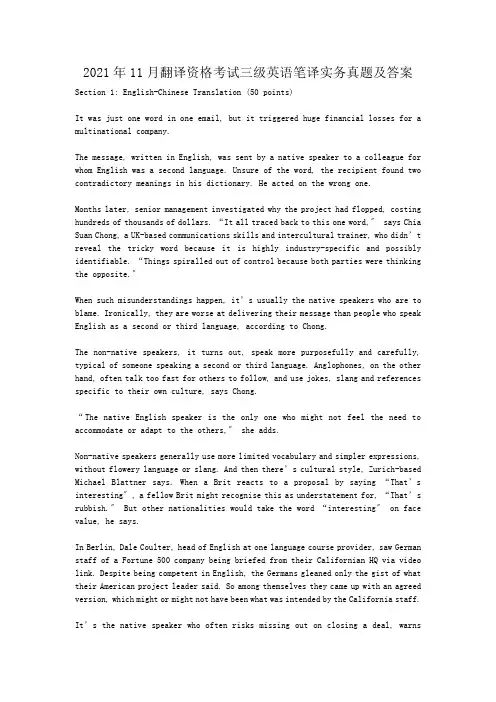
2021年11月翻译资格考试三级英语笔译实务真题及答案Section 1: English-Chinese Translation (50 points)It was just one word in one email, but it triggered huge financial losses for a multinational company.The message, written in English, was sent by a native speaker to a colleague for whom English was a second language. Unsure of the word, the recipient found two contradictory meanings in his dictionary. He acted on the wrong one.Months later, senior management investigated why the project had flopped, costing hundreds of tho usands of dollars. “It all traced back to this one word,〞 says Chia Suan Chong, a UK-based communications skills and intercultural trainer, who didn’t reveal the tricky word because it is highly industry-specific and possibly identifiable. “Things spiralle d out of control because both parties were thinking the opposite.〞When such misunderstandings happen, it’s usually the native speakers who are to blame. Ironically, they are worse at delivering their message than people who speak English as a second or third language, according to Chong.The non-native speakers, it turns out, speak more purposefully and carefully, typical of someone speaking a second or third language. Anglophones, on the other hand, often talk too fast for others to follow, and use jokes, slang and references specific to their own culture, says Chong.“The native English speaker is the only one who might not feel the need to accommodate or adapt to the others,〞 she adds.Non-native speakers generally use more limited vocabulary and simpler expressions, without flowery language or slang. And then there’s cultural style, Zurich-based Michael Blattner says. When a Brit reacts to a proposal by saying “That’s interesting〞, a fellow Brit might recognise this as understatement for, “That’s rubbish.〞But other nationalities would take the word “interesting〞 on face value, he says.In Berlin, Dale Coulter, head of English at one language course provider, saw German staff of a Fortune 500 company being briefed from their Californian HQ via video link. Despite being competent in English, the Germans gleaned only the gist of what their American project leader said. So among themselves they came up with an agreed version, which might or might not have been what was intended by the California staff.It’s the native speaker who often risks missing out on closing a deal, warnsFrenchman Jean-Paul Nerriere, formerly a senior international marketing executive at IBM.“Too many non-Anglophones, especially the Asians and the French, are too concerned about not ‘losing face’ — and nod approvingly while not getting the message at all,〞 he says.“When trying to communicate in English with a group of people with varying levels of fluency, it’s important to be receptive and adaptable, tuning your ears into a whole range of different ways of using English〞, says Jenkins, professor of global Englishes at the UK’s University of Southampton.“People who’ve learned other languages are good at doing that, but native speakers of English generally are monolingual and not very good at tuning in to language variation,〞 she says.In meetings, Anglophones tend to speed along at what they consider a normal pace, and also rush to fill gaps in conversation, according to Rob Steggles, senior marketing director for Europe at a telecommunications company.He recommends making the same point in a couple of different ways and asking for some acknowledg- ement, reaction or action.参考译文:区区电子邮件里的一个单词,导致一家跨国公司遭受巨大经济损失。
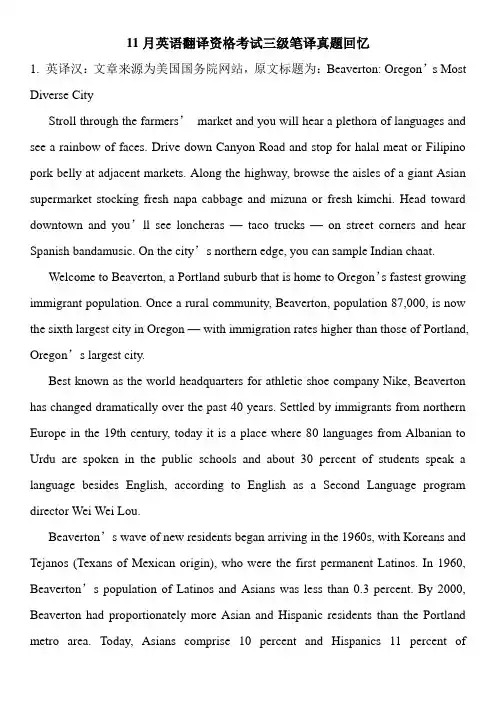
11月英语翻译资格考试三级笔译真题回忆1. 英译汉:文章来源为美国国务院网站,原文标题为:Beaverton: Oregon’s Most Diverse CityStroll through the farmers’market and you will hear a plethora of languages and see a rainbow of faces. Drive down Canyon Road and stop for halal meat or Filipino pork belly at adjacent markets. Along the highway, browse the aisles of a giant Asian supermarket stocking fresh napa cabbage and mizuna or fresh kimchi. Head toward downtown and you’ll see loncheras —taco trucks —on street corners and hear Spanish bandamusic. On the city’s northern edge, you can sample Indian chaat.Welcome to Beaverton, a Portland suburb that is home to Oregon’s fastest growing immigrant population. Once a rural community, Beaverton, population 87,000, is now the sixth largest city in Oregon — with immigration rates higher than those of Portland, Oregon’s largest city.Best known as the world headquarters for athletic shoe company Nike, Beaverton has changed dramatically over the past 40 years. Settled by immigrants from northern Europe in the 19th century, today it is a place where 80 languages from Albanian to Urdu are spoken in the public schools and about 30 percent of students speak a language besides English, according to English as a Second Language program director Wei Wei Lou.Beaverton’s wave of new residents began arriving in the 1960s, with Koreans and Tejanos (Texans of Mexican origin), who were the first permanent Latinos. In 1960, Beaverton’s population of Latinos and Asians was less than 0.3 percent. By 2000, Beaverton had proportionately more Asian and Hispanic residents than the Portland metro area. Today, Asians comprise 10 percent and Hispanics 11 percent ofBeaverton’s population.Mayor Denny Doyle says that many in Beaverton view the immigrants who are rapi dly reshaping Beaverton as a source of enrichment. “Citizens here especially in the arts and culture community think it’s fantastic that we have all these different possibilities here,” he says.Gloria Vargas, 50, a Salvadoran immigrant, owns a popular small restaurant, Gloria’s Secret Café, in downtown Beaverton. “I love Beaverton,” she says. “I feel like I belong here.” Her mother moved her to Los Angeles as a teenager in 1973, and she moved Oregon in 1979. She landed a coveted vendor spot in the Beaverton Farmers Market in 1999. Now in addition to running her restaurant, she has one of the most popular stalls there, selling up to 200 Salvadoran tamales — wrapped in banana leaves rather than corn husks —each Saturday. “Once they buy my food, they alwa ys come back for more,” she says.“It’s pretty relaxed here,” says Taj Suleyman, 28, born and raised in Lebanon, and recently transplanted to Beaverton to start a job working with immigrants from many countries. Half Middle Eastern and half African, Suleyman says he was attracted to Beaverton specifically because of its diversity. He serves on a city-sponsored Diversity Task Force set up by Mayor Doyle.Mohammed Haque, originally from Bangladesh, finds Beaverton very welcoming. His daughter, he boasts, was even elected her high school’s homecoming queen.South Asians such as Haque have transformed Bethany, a neighborhood north of Beaverton. It is dense with immigrants from Gujarat, a state in India and primary source for the first wave of Beaverton’s South Asian immigrants.The first wave of South Asian immigrants to Beaverton, mostly Gujaratis fromIndia, arrived in the 1960s and 1970s, when the motel and hotel industry was booming. Many bought small hotels and originally settled in Portland, and then relocated to Beaverton for better schools and bigger yards. The second wave of South Asians arrived during the high-tech boom of the 1980s, when the software industry, and Intel and Tektronix, really took off.Many of Beaverton’s Asians converge at Uwajimaya, a 30,000-square-foot supermarket near central Beaverton. Bernie Capell, former special events coordinator at Uwajimaya, says that many come to shop for fresh produce every day. But the biggest group of shoppers at Uwajimaya, she adds, are Caucasians.。

2021年11月翻译资格考试三级英语笔译实务真题及答案Section 1: English-Chinese Translation (50 points)It was just one word in one email, but it triggered huge financial losses for a multinational company.The message, written in English, was sent by a native speaker to a colleague for whom English was a second language. Unsure of the word, the recipient found two contradictory meanings in his dictionary. He acted on the wrong one.Months later, senior management investigated why the project had flopped, costing hundreds of tho usands of dollars. “It all traced back to this one word,〞 says Chia Suan Chong, a UK-based communications skills and intercultural trainer, who didn’t reveal the tricky word because it is highly industry-specific and possibly identifiable. “Things spiralle d out of control because both parties were thinking the opposite.〞When such misunderstandings happen, it’s usually the native speakers who are to blame. Ironically, they are worse at delivering their message than people who speak English as a second or third language, according to Chong.The non-native speakers, it turns out, speak more purposefully and carefully, typical of someone speaking a second or third language. Anglophones, on the other hand, often talk too fast for others to follow, and use jokes, slang and references specific to their own culture, says Chong.“The native English speaker is the only one who might not feel the need to accommodate or adapt to the others,〞 she adds.Non-native speakers generally use more limited vocabulary and simpler expressions, without flowery language or slang. And then there’s cultural style, Zurich-based Michael Blattner says. When a Brit reacts to a proposal by saying “That’s interesting〞, a fellow Brit might recognise this as understatement for, “That’s rubbish.〞But other nationalities would take the word “interesting〞 on face value, he says.In Berlin, Dale Coulter, head of English at one language course provider, saw German staff of a Fortune 500 company being briefed from their Californian HQ via video link. Despite being competent in English, the Germans gleaned only the gist of what their American project leader said. So among themselves they came up with an agreed version, which might or might not have been what was intended by the California staff.It’s the native speaker who often risks missing out on closing a deal, warnsFrenchman Jean-Paul Nerriere, formerly a senior international marketing executive at IBM.“Too many non-Anglophones, especially the Asians and the French, are too concerned about not ‘losing face’ — and nod approvingly while not getting the message at all,〞 he says.“When trying to communicate in English with a group of people with varying levels of fluency, it’s important to be receptive and adaptable, tuning your ears into a whole range of different ways of using English〞, says Jenkins, professor of global Englishes at the UK’s University of Southampton.“People who’ve learned other languages are good at doing that, but native speakers of English generally are monolingual and not very good at tuning in to language variation,〞 she says.In meetings, Anglophones tend to speed along at what they consider a normal pace, and also rush to fill gaps in conversation, according to Rob Steggles, senior marketing director for Europe at a telecommunications company.He recommends making the same point in a couple of different ways and asking for some acknowledg- ement, reaction or action.参考译文:区区电子邮件里的一个单词,导致一家跨国公司遭受巨大经济损失。
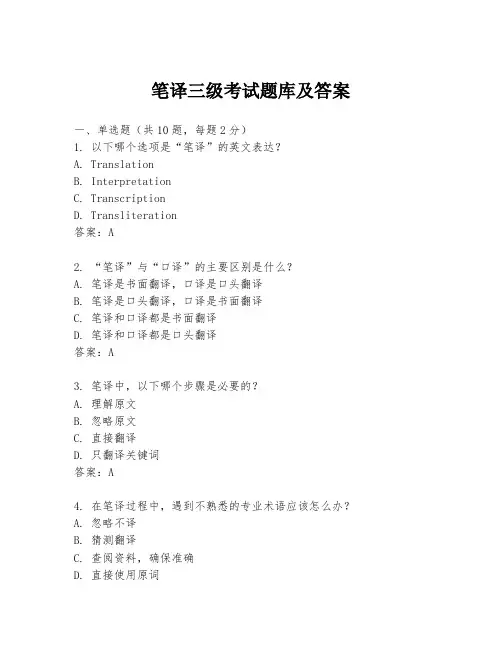
笔译三级考试题库及答案一、单选题(共10题,每题2分)1. 以下哪个选项是“笔译”的英文表达?A. TranslationB. InterpretationC. TranscriptionD. Transliteration答案:A2. “笔译”与“口译”的主要区别是什么?A. 笔译是书面翻译,口译是口头翻译B. 笔译是口头翻译,口译是书面翻译C. 笔译和口译都是书面翻译D. 笔译和口译都是口头翻译答案:A3. 笔译中,以下哪个步骤是必要的?A. 理解原文B. 忽略原文C. 直接翻译D. 只翻译关键词答案:A4. 在笔译过程中,遇到不熟悉的专业术语应该怎么办?A. 忽略不译B. 猜测翻译C. 查阅资料,确保准确D. 直接使用原词答案:C5. 笔译时,以下哪种翻译策略是不恰当的?A. 直译B. 意译C. 逐字翻译D. 灵活变通答案:C6. 笔译中,如何处理原文中的文化元素?A. 直接翻译B. 忽略不译C. 适当解释或注释D. 替换为本国文化元素答案:C7. 笔译三级考试主要考察哪些能力?A. 语言知识B. 翻译技巧C. 文化理解D. 以上都是答案:D8. 笔译三级考试的合格标准是什么?A. 总分达到60分B. 总分达到70分C. 总分达到80分D. 总分达到90分答案:A9. 笔译三级考试中,以下哪个部分是不需要的?A. 阅读理解B. 词汇测试C. 翻译实践D. 数学计算答案:D10. 笔译三级考试的评分标准主要依据什么?A. 翻译速度B. 翻译准确性C. 翻译流畅性D. 以上都是答案:D二、阅读理解(共2篇,每篇5题,每题3分)(文章内容省略)11. 文章主要讨论了什么主题?A. 环境保护B. 经济发展C. 文化交流D. 科技创新答案:C12. 作者认为文化交流的重要性体现在哪些方面?A. 促进经济发展B. 增进相互理解C. 保护文化遗产D. 以上都是答案:D13. 文章中提到的“文化冲突”主要指什么?A. 不同文化之间的竞争B. 不同文化之间的误解C. 不同文化之间的融合D. 不同文化之间的排斥答案:B14. 作者建议如何处理文化冲突?A. 避免交流B. 强制同化C. 尊重差异D. 忽视问题答案:C15. 文章最后呼吁采取什么行动?A. 加强文化保护B. 促进文化融合C. 抵制外来文化D. 限制文化交流答案:B(第二篇阅读理解题目省略)三、翻译实践(共2题,每题15分)16. 将以下句子从英文翻译成中文:"In the context of globalization, cultural exchange plays a vital role in fostering mutual understanding and respect among different nations."答案:在全球化的背景下,文化交流在促进不同国家之间的相互理解和尊重方面发挥着至关重要的作用。
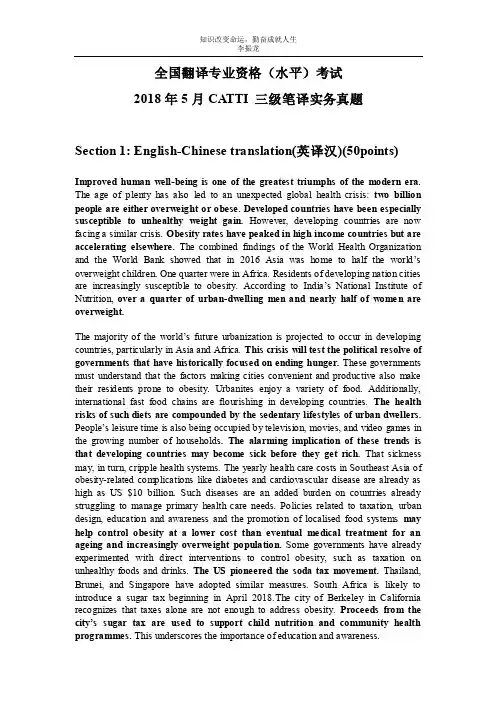
知识改变命运,勤奋成就人生李振龙全国翻译专业资格(水平)考试2018年5月CATTI 三级笔译实务真题Section 1: English-Chinese translation(英译汉)(50points) Improved human well-being is one of the greatest triumphs of the modern era. The age of plenty has also led to an unexpected global health crisis: two billion people are either overweight or obese. Developed countries have been especially susceptible to unhealthy weight gain. However, developing countries are now facing a similar crisis. Obesity rates have peaked in high income countries but are accelerating elsewhere. The combined findings of the World Health Organization and the World Bank showed that in 2016 Asia was home to half the world’s overweight children. One quarter were in Africa. Residents of developing nation cities are increasingly susceptible to obesity. According to India’s National Institute of Nutrition, over a quarter of urban-dwelling men and nearly half of women are overweight.The majority of the world’s future urbanization is projected to occur in developing countries, particularly in Asia and Africa. This crisis will test the political resolve of governments that have historically focused on ending hunger. These governments must understand that the factors making cities convenient and productive also make their residents prone to obesity. Urbanites enjoy a variety of food. Additionally, international fast food chains are flourishing in developing countries. The health risks of such diets are compounded by the sedentary lifestyles of urban dwellers. People’s leisure time is also being occupied by television, movies, and video games in the growing number of households. The alarming implication of these trends is that developing countries may become sick before they get rich. That sickness may, in turn, cripple health systems. The yearly health care costs in Southeast Asia of obesity-related complications like diabetes and cardiovascular disease are already as high as US $10 billion. Such diseases are an added burden on countries already struggling to manage primary health care needs. Policies related to taxation, urban design, education and awareness and the promotion of localised food systems may help control obesity at a lower cost than eventual medical treatment for an ageing and increasingly overweight population. Some governments have already experimented with direct interventions to control obesity, such as taxation on unhealthy foods and drinks. The US pioneered the soda tax movement. Thailand, Brunei, and Singapore have adopted similar measures. South Africa is likely to introduce a sugar tax beginning in April 2018.The city of Berkeley in California recognizes that taxes alone are not enough to address obesity. Proceeds from the city’s sugar tax are used to support child nutrition and community health programmes. This underscores the importance of education and awareness.。
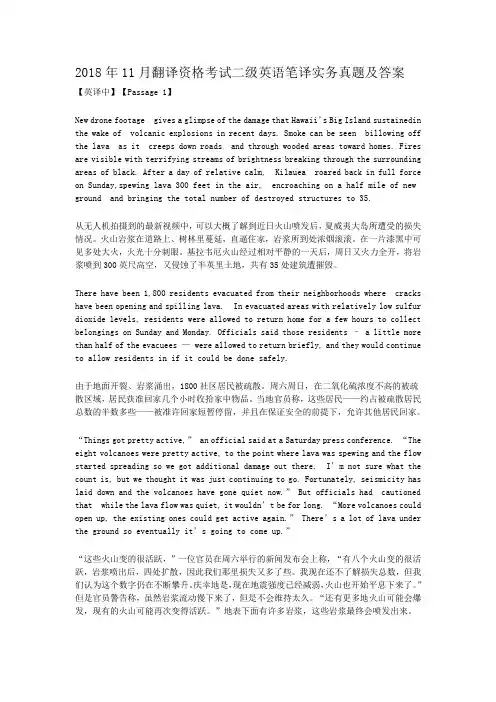
2018年11月翻译资格考试二级英语笔译实务真题及答案【英译中】【Passage 1】New drone footage gives a glimpse of the damage that Hawaii’s Big Island sustainedin the wake of volcanic explosions in recent days. Smoke can be seen billowing off the lava as it creeps down roads and through wooded areas toward homes. Fires are visible with terrifying streams of brightness breaking through the surrounding areas of black. After a day of relative calm, Kilauea roared back in full force on Sunday,spewing lava 300 feet in the air, encroaching on a half mile of new ground and bringing the total number of destroyed structures to 35.从无人机拍摄到的最新视频中,可以大概了解到近日火山喷发后,夏威夷大岛所遭受的损失情况。
火山岩浆在道路上、树林里蔓延,直逼住家,岩浆所到处浓烟滚滚。
在一片漆黑中可见多处大火,火光十分刺眼。
基拉韦厄火山经过相对平静的一天后,周日又火力全开,将岩浆喷到300英尺高空,又侵蚀了半英里土地,共有35处建筑遭摧毁。
There have been 1,800 residents evacuated from their neighborhoods where cracks have been opening and spilling lava. In evacuated areas with relatively low sulfur dioxide levels, residents were allowed to return home for a few hours to collect belongings on Sunday and Monday. Officials said those residents – a little more than half of the evacuees — were allowed to return briefly, and they would continue to allow residents in if it could be done safely.由于地面开裂、岩浆涌出,1800社区居民被疏散。
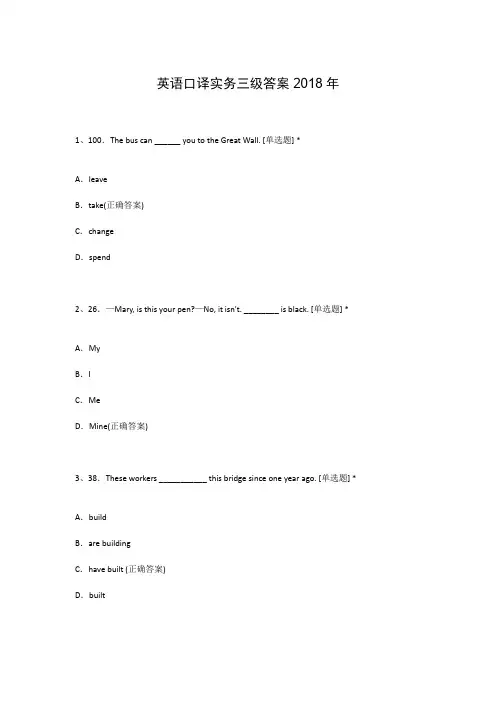
英语口译实务三级答案2018年1、100.The bus can ______ you to the Great Wall. [单选题] *A.leaveB.take(正确答案)C.changeD.spend2、26.—Mary, is this your pen?—No, it isn't. ________ is black. [单选题] * A.MyB.IC.MeD.Mine(正确答案)3、38.These workers ___________ this bridge since one year ago. [单选题] * A.buildB.are buildingC.have built (正确答案)D.built4、?I am good at schoolwork. I often help my classmates _______ English. [单选题] *A. atB. toC. inD. with(正确答案)5、—Where did you get the book?—From my friend. I ______ it three days ago. ()[单选题] *A. lentB. borrowed(正确答案)C. keptD. returned6、Be careful when you _______ the street. [单选题] *A. are crossingB. is crossingC. cross(正确答案)D. is cross7、Mum, this T-shirt is much too small for me. Would you buy me a _______ one? [单选题] *A. niceB. largeC. nicerD. larger(正确答案)8、It was _____the policeman came_____the parents knew what had happened to their son. [单选题] *A.before…asB. until…whenC. not until…that(正确答案)D.until…that9、—______ do you pay for it? —Over the Internet. ()[单选题] *A. WhatB. How muchC. How(正确答案)D. When10、We should _______ a hotel before we travel. [单选题] *A. book(正确答案)B. liveC. stayD. have11、———Must I return the book you lent me to you now? ——No, you( ). You can keep it for another few days. [单选题] *A.can’tB. shouldn'tC. mustn'tD. don, t have to(正确答案)12、I think you should buy this novel. It is really worth _____. [单选题] *A. reading(正确答案)B. being readC. readD. to read13、_______ after dinner is good for our health. [单选题] *A. WalksB. Walking(正确答案)C. WalkedD. Walk14、The more he tried to please her, _____she seemed to appreciate it. [单选题] *A.lessB.lesserC.the less(正确答案)D.the lesser15、David ______ at home when I called at seven o’clock yesterday evening. ()[单选题] *A. didn’tB. doesn’tC. wasn’t(正确答案)D. isn’t16、24.I often ask my English teacher some questions ________ e-mail. [单选题] *A.by(正确答案)B.inC.forD.with17、Where have you _______ these days? [单选题] *A. been(正确答案)B. beC. isD. are18、A small village cuts across the river. [单选题] *A. 切B. 穿过(正确答案)C. 划船D. 踢19、Her ideas sound right, but _____ I'm not completely sure. [单选题] *A. somehow(正确答案)B. somewhatC. somewhereD. sometime20、His handwriting is better than _____. [单选题] *A. mine(正确答案)B. myC. ID. me21、I hadn't realized she was my former teacher _____ she spoke [单选题] *A. asB. sinceC. until(正确答案)D. while22、It’s reported that there are more than 300?_______ smokers in China. [单选题] *A. million(正确答案)B. millionsC. million ofD. millions of23、75.Why not________ for a walk? [单选题] *A.go out(正确答案)B.to go outC.going outD.goes out24、______ pocket money did you get when you were a child? ()[单选题] *A. WhatB. HowC. How manyD. How much(正确答案)25、—What can I do to help at the old people’s home?—You ______ read stories to the old people. ()[单选题] *A. could(正确答案)B. mustC. shouldD. would26、Study hard, ______ you won’t pass the exam. [单选题] *A. or(正确答案)B. andC. butD. if27、This is the news _______ you want to know. [单选题] *A. that(正确答案)B. whatC. whenD. who28、The beautiful radio _______ me 30 dollars. [单选题] *A. spentB. paidC. cost(正确答案)D. took29、It seems slow for children to become _____ ,while adults often feel time flies. [单选题] *A. growns-upsB. growns-upC. grown upsD. grown-ups(正确答案)30、He studied harder to _______ his reading skills. [单选题] *A. improve(正确答案)B. rememberC. memorizeD. forget。
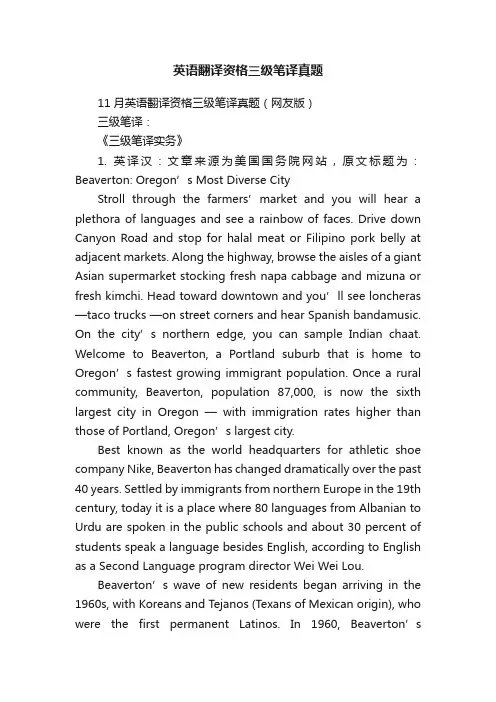
英语翻译资格三级笔译真题11月英语翻译资格三级笔译真题(网友版)三级笔译:《三级笔译实务》1. 英译汉:文章来源为美国国务院网站,原文标题为:Beaverton: Oregon’s Most Diverse CityStroll through the farmers’market and you will hear a plethora of languages and see a rainbow of faces. Drive down Canyon Road and stop for halal meat or Filipino pork belly at adjacent markets. Along the highway, browse the aisles of a giant Asian supermarket stocking fresh napa cabbage and mizuna or fresh kimchi. Head toward downtown and you’ll see loncheras —taco trucks —on street corners and hear Spanish bandamusic. On the city’s northern edge, you can sample Indian chaat. Welcome to Beaverton, a Portland suburb that is home to Oregon’s fastest growing immigrant popul ation. Once a rural community, Beaverton, population 87,000, is now the sixth largest city in Oregon —with immigration rates higher than those of Portland, Oregon’s largest city.Best known as the world headquarters for athletic shoe company Nike, Beaverton has changed dramatically over the past 40 years. Settled by immigrants from northern Europe in the 19th century, today it is a place where 80 languages from Albanian to Urdu are spoken in the public schools and about 30 percent of students speak a language besides English, according to English as a Second Language program director Wei Wei Lou.Beaverton’s wave of new residents began arriving in the 1960s, with Koreans and Tejanos (Texans of Mexican origin), who were the first permanent Latinos. In 1960, Beaverton’spopulation of Latinos and Asians was less than 0.3 percent. By 2000,Beaverton had proportionately more Asian and Hispanic residents than the Portland metro area. Today, Asians comprise 10 percent and Hispanics 11 percent of Beaverton’s populat ion.Mayor Denny Doyle says that many in Beaverton view the immigrants who are rapidly reshaping Beaverton as a source of enrichment. “Citizens here especially in the arts and culture community think it’s fantastic that we have all these different possibil itiees here,” he says.Gloria Vargas, 50, a Salvadoran immigrant, owns a popular small restaurant, Gloria’s Secret Café, in downtown Beaverton. “I love Beaverton,” she says. “I feel like I belong here.” Her mother moved her to Los Angeles as a teenager in 1973, and she moved Oregon in 1979. She landed a coveted vendor spot in the Beaverton Farmers Market in 1999. Now in addition to running her restaurant, she has one of the most popular stalls there, selling up to 200 Salvadoran tamales —wrapped in banana leaves rather than corn husks —each Saturday. “Once they buy my food, they alw ays come back for more,” she says.“It’s pretty relaxed here,” says Taj Suleyman, 28, born and raised in Lebanon, and recently transplanted to Beaverton to start a job working with immigrants from many countries. Half Middle Eastern and half African, Suleyman says he was attracted to Beaverton specifically because of its diversity. He serves on a city-sponsored Diversity Task Force set up by Mayor Doyle.Mohammed Haque, originally from Bangladesh, finds Beaverton very welcoming. His daughter, he boasts, was even elected her high school’s homecoming queen.South Asians such as Haque have transformed Bethany, aneighborhood north of Beaverton. It is dense with immigrants from Gujarat, a state in India and primarysource for the first wave of Beaverton’s South Asian immigrants.The first wave of South Asian immigrants to Beaverton, mostly Gujaratis from India, arrived in the 1960s and 1970s, when the motel and hotel industry was booming. Many bought small hotels and originally settled in Portland, and then relocated to Beaverton for better schools and bigger yards. The second wave of South Asians arrived during the high-tech boom of the 1980s, when the software industry, and Intel and Tektronix, really took off.Many of Beaverton’s Asians converge at Uwajimaya, a 30,000-square-foot supermarket near central Beaverton. Bernie Capell, former specialevents coordinator at Uwajimaya, says that many come to shop for fresh produce every day. But the biggest group of shoppers at Uwajimaya, she adds, are Caucasians.Beaverton’s Asian population boasts a sizable number of Koreans, who began to arrive in the late 1960s and early 1970s.According to T ed Chung, a native of Korea and Beaverton resident since 1978, three things stand out about his fellow Korean immigrants. Upon moving to Beaverton, they join a Christian church —often Methodist or Presbyterian —as a gathering place; they push their children to excel in school; and they shun the spotlight.Chung says he and his fellow Korean émigrés work hard as small businessmen —owning groceries, dry cleaners, laundromats, delis, and sushi shops — and are frugal so they can send their children to a leading university.Most recently, immigrants from Central and South America,as well as refugees from Iraq and Somalia, have joined the Beaverton community.Many Beaverton organizations help immigrants.The Beaverton Resource Center helps all immigrants with health and literacy services.The Somali Family Education Center helps Somalis and other African refugees to get settl ed. And one Beaverton elementary school even came up with the idea of a “sew in”—parents of students sewing together —to welcome Somali Bantu parents and bridge major cultural differences.Historically white churches, such as Beaverton First United Methodist Church, offer immigration ministries. And Beaverton churches of all denominations host Korean- or Spanish-language services.Beaverton’s Mayor Doyle wants refugee and immigrant leaders to participate in the town’s decision-making. He set up a Divers ity Task Force whose mission is “to build inclusive and equitable communities in the City of Beaverton.” The task force is working to create a multicultural community center for Beavertonians of all backgrounds.The resources and warm welcome that Beaverton gives immigrants are reciprocated in the affection that many express for their new home.Kaltun Caynan, 40, a Somali woman who came to Beaverton in 2001 fleeing civil war, is an outreach coordinator for the Somali Family Education Center. “I like it so much,” she said, cheerfully. “Nobody discriminate[s against] me, everybody smiling at me.”参考译文:漫步走过农贸市场,你会听到各种语言,见到各式各样的面孔。
2012年11月翻译资格考试三级英语笔译实务真题及答案Section 1 English-Chinese Translation (英译汉) (60 points)Translate the following passage into Chinese. The time for this section is 120 minutes.FOR MORE than 30 years, I have been wondering about L.R. Generson. On one of our first Christmases together, my husband gave me a complete set of Dickens. There were 20 volumes, bound in gray cloth with black corners, old but in good condition. Stamped on the flyleafof each volume, in faded block letters, was the name of the prev ious owner: “L.R. Generson, M.D., Bronx, NY.”That Dickens set is one of the best presents anyone has ever given me. A couple of the books are still pristine, but others - “Bleak House,’’ “David Copperfield,’’ and especially “Great Expectations’’ - have been read and re-read almost to pieces. Over the years, Pip and Estella and Magwitch have kept me company. So have Lady Dedlock, Steerforth and Peggotty, the Cratchits and the Pecksniffs and the Veneerings. And so,in his silent enigmatic way, has L.R. Generson.Did he love the books as much as I do? Who was he? On a whim, I Googled him. There wasn’t much - a single mention on a veterans’ website of a World War II captain named Leonard Generson. But I did find a Dr. Richard Generson, an oral surgeon living in New Jersey. Since Generson is not a common name, I decided to write to him.Dr. Generson was kind enough to write back. He told me that his father, Leonard Richard Generson, was born in 1909. He lived in New York City but went to medical school in Basel, Switzerland. He spoke 10 languages fluently. As an obstetrician and gynecologist, he opened a practice in the Bronx shortly before World War II. His son described himas “an extremely patriotic individual’’; right after Pearl Harb or he closed his practice and enlisted. He served throughout the war as a general surgeon with an airborne special forces unit in Europe, where he became one of the war’s most highly decorated physicians.The list of his decorations reflects his ordeals and his courage: multiple Purple Hearts, the Bronze Star with “V’’ for valor, the Silver Star, and also the Cross of War,an extremely high honor from the government of France. After the war, he remained in the Army Reserve and attained the rank of full colonel, while also continuing his medical practice in New York. “He was a very dedicated physician who had a large patient following,’’ his son wrote.Leonard Generson’s son didn’t remember the Dickens set, though he told me that there were always a lot of novels in the house. His mother probably “cleaned house’’ after his father’s death in 1977 - the same year my husband bought the set in a used book store.I found this letter very moving, with its brief portrait of an intelligent, brave man and his life of service. At the same time, it made me question my presumption that somehowL.R. Generson and I were connected because we’d owned the same set of books. The letter both told me a little about him, and told me that I would never really know anything about him - and why should I? His son must have been startled to hear from a stranger on such a fragile pretext. What had I been thinking?One possible, and only somewhat facetious, answer is that I’ve read too much Dickens. In the world of a Dickens novel, everything is connected to everything else. Orphans find families. Lovers are joined (or parted and morally strengthened). Ancient mysteries are solved and old scores are settled. Questions are answered. Stories end.Dickens’s cluttered network of connected lives brilliantly exaggerates something that is true of all of us. We want to impose order through telling stories, maybe because there is so much we don’t know about our own stories and the stories of those around us.Leonard Generson’s life touched mine only lightly, through the coincidence of a set of books. But there are other lives he touched more deeply. The next time I read a Dickens novel, I will think of him and his military service and his 10 languages. And I will think of the hundreds of babies he must have delivered, who are now in the middle of their own lives and their own stories.Section 2 Chinese-English Translation (汉译英)(40 points)Translate the following passage into English. The time for this section is 60 minutes.总部位于美国印第安纳州的得而达(Delta)水龙头公司是美国一家上市公司Masco集团的核心企业。
2022年11月翻译资格考试三级英语笔译实务真题及答案英译汉Traces of microplastics and hazardous chemicals found in majority of snow and ice samples taken earlier this year.Plastic and traces of hazardous chemicals have been found in Antarctica, one of the world’s last great wil dernesses, according to a new study.Researchers spent three months taking water and snow samples from remote areas of the continent earlier this year.These have now been analysed and researchers have confirmed the majority contained “persistent hazardo us chemicals〞 or microplastics.The findings come amid growing concern about the extent of the plastic pollution crisis which scientists have warned risks “permanent contamination〞of the planet.Earlier this week, the UN warned it is one of the world’s biggest environmental threats and said although 60 countries were taking urgent action more needed to be done.The new report by researchers at Greenpeace is part of global campaign to create the world’s biggest ocean sanctuary in the seas around Antarcti ca to protect the fragile ecosystem from industrial fishing and climate change.Frida Bengtsson, of Greenpeace’s Protect the Antarctic campaign, said the findings proved that even the most remote areas of the planet were not immune from the impact of manmade pollution.“We need action at source, to stop these pollutants ending up in the Antarctic in the first place, and we need an Antarctic ocean sanctuary to give space for penguins, whales and the entire ecosystem to recover from the pressures they’re fa cing,〞she said.Seven of the eight sea-surface water samples tested contained microplastics such as microfibres. Seven of the nine snow samples tested contained detectable concentrations of the persistent hazardous chemicals – polyfluorinated alkylated substances, or PFAS.Researchers said the chemicals are widely used in many industrial processes andconsumer products and have been linked to reproductive and developmental issues in wildlife. They said the snow samples gathered included freshly fallen snow, suggesting the hazardous chemicals had come from contaminated rain or snowfall.Prof Alex Rogers, a specialist in sustainable oceans at the Oxford Martin school, Oxford University, said the discovery of plastics and chemicals in Antarctica confirmed that manmade pollutants were now affecting ecosystems in every corner of the world.And he warned the consequences of this pervasive contamination remained largely unknown.“The big question now is what are the actual consequences of finding this stuff here? Many of these chemicals are pretty nasty and as they move up the food chain they may be having serious consequences for the health of wildlife, and ultimately humans. The effects of microplastics on marine life, likewise, are largely not understood,〞 he said.There is relatively little data on the extent of microplastics in Antarctic waters, and researchers said they hoped this new study would lead to a greater understanding of the global extent of plastic and chemical pollutants.Bengtsson said: “Pla stic has now been found in all corners of our oceans, from the Antarctic to the Arctic and at the deepest point of the ocean, the Mariana trench. We need urgent action to reduce the flow of plastic into our seas and we need large-scale marine reserves –like a huge Antarctic ocean sanctuary which over 1.6m people are calling for –to protect marine life and our oceans for future generations.〞参考答案:在今年早些时候采集的大部分冰雪样本中发现了微量塑料和有害化学物质。